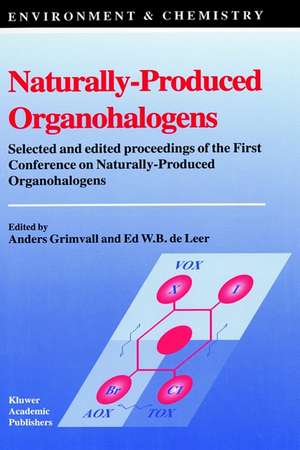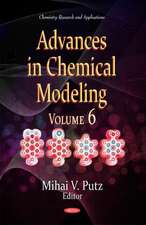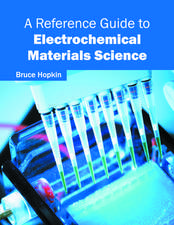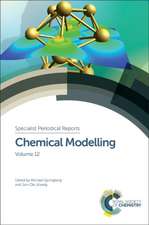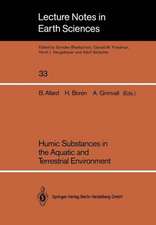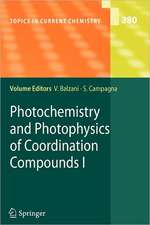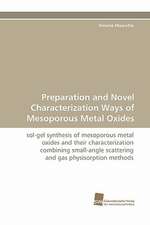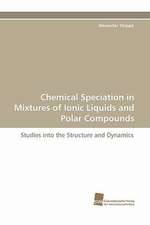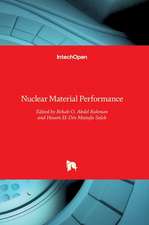Naturally-Produced Organohalogens: Environment & Chemistry, cartea 1
Editat de Anders Grimvall, Ed W.B. de Leeren Limba Engleză Hardback – 31 mai 1995
Those in favour argue that certain chlorinated compounds (PCBs, DDT, CFCs, etc.) have large negative environmental effects. The use of chlorine in disinfectants leads to the production of chloroform, while bulk products (PVC) contribute to the production of chlorinated dibenzo-p-dioxins and dibenzofurans when they are burned.
Those against argue that chlorine and many chlorinated compounds are essential in the control of human health (the prevention of disease transmitted through drinking water that has not been disinfected), and that chlorinated compounds are indispensable intermediates in many production processes, representing a vast economic value.
But such discussions often ignore the fact that Nature contributes significantly to the production of chlorinated organic compounds. More than 1000 such compounds are known, and their contribution to the biogeochemical cycling of chlorine is underestimated. Chlorine is organically bound in large quantities to humic materials, and natural production mechanisms are known for low molecular weight compounds (methyl chloride, chloroform, chlorinated dibenzo-p-dioxins and dibenzofurans). The role of these compounds in the environment is largely unknown.
Naturally-Produced Organohalogens gives a complete overview of the present state of knowledge on the subject, giving a much needed balance to the argument sketched out above.
| Toate formatele și edițiile | Preț | Express |
|---|---|---|
| Paperback (1) | 951.91 lei 6-8 săpt. | |
| SPRINGER NETHERLANDS – 5 noi 2012 | 951.91 lei 6-8 săpt. | |
| Hardback (1) | 958.25 lei 6-8 săpt. | |
| SPRINGER NETHERLANDS – 31 mai 1995 | 958.25 lei 6-8 săpt. |
Preț: 958.25 lei
Preț vechi: 1168.60 lei
-18% Nou
Puncte Express: 1437
Preț estimativ în valută:
183.36€ • 191.93$ • 152.61£
183.36€ • 191.93$ • 152.61£
Carte tipărită la comandă
Livrare economică 31 martie-14 aprilie
Preluare comenzi: 021 569.72.76
Specificații
ISBN-13: 9780792334354
ISBN-10: 0792334353
Pagini: 437
Ilustrații: XIV, 437 p.
Dimensiuni: 155 x 235 x 25 mm
Greutate: 0.81 kg
Ediția:1995
Editura: SPRINGER NETHERLANDS
Colecția Springer
Seria Environment & Chemistry
Locul publicării:Dordrecht, Netherlands
ISBN-10: 0792334353
Pagini: 437
Ilustrații: XIV, 437 p.
Dimensiuni: 155 x 235 x 25 mm
Greutate: 0.81 kg
Ediția:1995
Editura: SPRINGER NETHERLANDS
Colecția Springer
Seria Environment & Chemistry
Locul publicării:Dordrecht, Netherlands
Public țintă
ResearchCuprins
1 General introduction and overview articles.- Evidence of naturally produced and man-made organohalogens in water and sediments.- The contribution of natural halogenation processes to the atmospheric halomethane burden.- Origin and occurrence of halogenated organic matter in soil.- AOX in groundwater.- 2 Characterization of organohalogens of natural origin.- Isolation of XAD-4 acids from natural waters and their importance as precursors to TOX and THM upon chlorination.- Natural AOX in the river Rhine: modelling and trace analysis.- Halogenated structural elements in naturally occurring organic matter.- Chemical characterization of organohalogens in a coniferous forest soil.- Chemical characterisation of adsorbable organic halogens (AOX) in precipitation.- Naturally produced organic chlorine in the Finnish aquatic environment.- 3 Natural production of organohalogens normally considered to be of anthropogenic origin.- Are polychlorinated biphenyls produced naturally ? Results from recent UK investigations.- Formation of organic chlorine compounds of low molecular weight in the chloroperoxidase-mediated reaction between chloride and humic material.- 4 Mechanisms for the incorporation of halogens into organic substances.- Incorporation of halogenated substances into humic material.- Detoxification of chlorophenols in soils by oxidative transformations on manganese and iron oxides.- On the possible role of humic materials in the environmental organohalogen budget: The enzymatically mediated incorporation of 4-chlorophenol into humic acids.- Reaction mechanism and 3-dimensional structure of bacterial non-haem haloperoxidases.- Structures of aquatic humic substances responsible for the reaction with chlorine.- Incorporation of haloalkanes into long chain fatty acids by the chloroalkane-degrading bacterium Rhodococcus rhodochrous NCIMB 13064.- Kinetic control of the biogeochemical formation of halogenated humic acids.- 5 Occurrence and production of organohalogens in the terrestrial environment.- The natural chlorinated plant hormone of pea, 4-chloroindole-3-acetic acid, an endogenous herbicide?.- Biosynthesis and metabolic role of chloromethane in fungi.- Occurrence of fluoroacetate, a naturally-produced organohalogen in plants.- Significant fungal biogenesis of physiologically important chlorinated aromatics in natural environments.- Naturally produced organohalogens: AOX-monitoring in plants and sediments.- Biosynthesis of fluoroacetate and 4-fluorothreonine by Streptomyces cattleya.- 6 Occurrence and production of organohalogens in the marine environment.- Marine phytoplankton as a natural source of volatile organohalogens.- Iodinated C1-C4 hydrocarbons released from ice algae in Antarctica.- Occurrence of halogenated fatty acids in bivalve lipids.- Formation and distribution of halogenated volatile organics in sea water.- The natural formation of trichloroethylene and perchloroethylene in sea water.- Occurrence of organic halogens in marine mammals.- Origin of organohalogens found in Baltic Sea sediments.- Bromoperoxidase from a marine red alga, Corallina pilulifera.- 7 Reactive chlorine and halogenated organic compounds in the atmosphere.- Inorganic Cl cycling in the marine boundary layer: a review.- Production of a photolytic precursor of atomic Cl from aerosols and Cl- in the presence of O3.- Biogenic emission of organobromine compounds to the Arctic Ocean and atmosphere.- Chlorinated C1- and C2-hydrocarbons in the needles of Scots Pine (Pinus sylvestris L.) in three forests of Northern Britain.- 8 Policy aspects.- From ‘is’ to‘ought’.- Occurrence and toxicology of natural and anthropogenic organohalogens and relevance to environmental protection.- What is the opinion of a policy-maker on naturally produced organohalogens? The governmental point of view.
